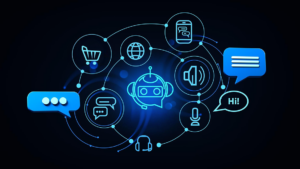

Pooja Naik
Top 10 Benefits of Implementing Chatbots in Retail
Time. Convenience. Value. The holy trinity for customers. Gone are the days when retail customers use to navigate through varied number of websites on computers and cellphones, the long wait to connect to a service representative through Interactive Voice Response systems & live chats. It’s time for traditional retailers to implement chatbots across their ecosystem to engage customers throughout the path to purchase journey with a human touch. By implementing chatbots in retail, customer satisfaction and engagement, and thereby revenue and gross margins can be improved. Every piece of technology has had humble beginnings, and chatbots are expected to be the next level shift in customer engagement. The technology is becoming better every day, capable of understanding context, maintaining conversational flow (i.e. not sounding like robots), and generally providing increasingly accurate responses and because of this, the retail industry is highly benefited.
What are Chatbots?
A blend word of chat and robots, chatbots are software programs that provide a natural media to interact with the end user. Unlike traditional software programs that are more UI driven with graphical and textual content presented to the user in a predetermined order, chatbots provide a more intuitive interface to the users. Chatbots can ask questions and respond to queries through text in a manner that mimics natural human conversation. They are the result of advancements in Natural Language Processing, Machine Learning, Data Analytics and Big Data. Good examples would be Google Assistant on the Allo app, the Facebook bot on their Messenger app etc. Right now, most of these are simplistic and often experimental versions.
“So chatbots: the user asks questions, it responds, and learns along the way. Simple enough.”
Benefits of Implementing Chatbots in Retail
The advantages of implementing chatbots in retail is not only limited to enhanced customer satisfaction and engagement, it also helps retailers to streamline their operational processes. Some of the key benefits are as follows:
1. Conversational Commerce
You probably saw this coming. Possibly the biggest area that stands to benefit from chatbot integration is the commerce industry in both the product space as well as the service sector. Currently, navigating across a clunky webpage with inaccurate search results is undesirable customer experience. Chatbots could become the new way to shop online, with their capabilities to understand natural language, providing expected range of products, contextual feedback, and learning from previous browsing to provide better suggestions, etc.
2. Omni-Channel Presence
Most chatbots are platform independent, and are available on several different channels. They have no technological restrictions like personal digital assistants such as Siri, which are partly integrated into the OS. A lot of these chatbots are presented as another end user to the service, thus making it easier to deploy and integrate them into the platform. This maximizes reach as the bots are deployed on multiple platforms such as Facebook, SMS, and Twitter etc., where the presence of customer already exists and encourages multi-channel engagement leading to increased brand perception and outreach.
3. Increased Revenue
From an organizational view, integrating chatbots in retail can contribute towards increased revenue margins. Due to its advanced learning capabilities, chatbots can provide increasingly relevant responses, and even make educated guesses as to what the customer might need and notify them. This sort of customer interaction keeps them engaged, generating more revenue for your business. There are other benefits such as reduced infrastructural investments (no telephone line, no office space for personnel etc.) as well.
4. Real-Time Notifications
Notifying your suppliers/distributors with operational insights and most importantly your potential customers about latest collections and trendiest pieces is mandatory. Chatbots help retailers to reach out to the distributors or customers in real-time. Conventional marketing i.e. through emails will be replaced by chatbots as it can recommend trending collections in a casual and cheerful manner and, which in return makes customer to browse more and look for more products.
5. Instant Feedback
Humans cannot be replaced by chatbots, but they can think and answer to the queries as humans do. A customer can instantly reach out to the retailer when they face any issue with the service or product provided by them at any point of time and can get their problems addressed in real-time. Also, instant feedbacks from the customers can help the retailer take corrective action to streamline their business processes.
6. Efficient Training of Employees
A good organization not only focuses on their customer’s needs and demands but also takes care of its employees by nurturing their skills. By using chatbots in retail, a retailer can assign role specific skills to their employees and monitor their individual progress. Chatbots can even provide large scale training of employees, providing personalized feedbacks based on test results, supporting their career growth and development.
7. In-store Assistance
Chatbots can also act as in-store assistants, aiding retail sales associates by interacting with customers, offering functionalities such as inventory look-up, cross-sell/up-sell suggestions, and discount suggestions etc. Chatbots can provide detailed purchase history, liking and disliking of a respective customer towards a product, which in return will help the associates to build a relation of trust and confidence.
8. Workforce Scheduling
Planning/ scheduling a week can be the biggest pain for any manager. A calendar system can be automated by a chatbot which is coordinating with another person or bot. After coordinating with the situations and happenings, chatbots can send the user their respective weekly plan. Users can change or block the busy time slots and in those situations a chatbots can reschedule the plan based on the skills of the employee and available time frames.
9. Order Tracking
It can be easy as a pie to track the shipped order through chatbots. The number of steps can be effectively reduced that a user has to go through to get the shipping information. All a customer can do is type “shipping information” in a messenger app, rest will be taken care by chatbots. A step by step shipment activity list will be made available to the customer.
10. Better Customer Service Satisfaction
Customer satisfaction is a key parameter in retaining customers and enhancing overall brand reputation as a reliable business entity. Chatbots in retail can eliminate the biggest potential cause of customer dissatisfaction – long wait times. Since there can be infinite number of chatbots handling customer queries, the resolution time will not be much. Along with the added benefit of conversing in a natural language, customers would no longer consider contacting is a tough task filled with long wait times. With chatbots for customer service, both customers and store assistants are winners.
In near future, chatbots would be able to understand the emotional state of the customers as well, thus more sympathetic and relevant responses can be expected. Keeping in mind the numerous benefits of implementing chatbots in retail, it’s high time for retailers to start strategizing and integrating chatbots across their ecosystem.





